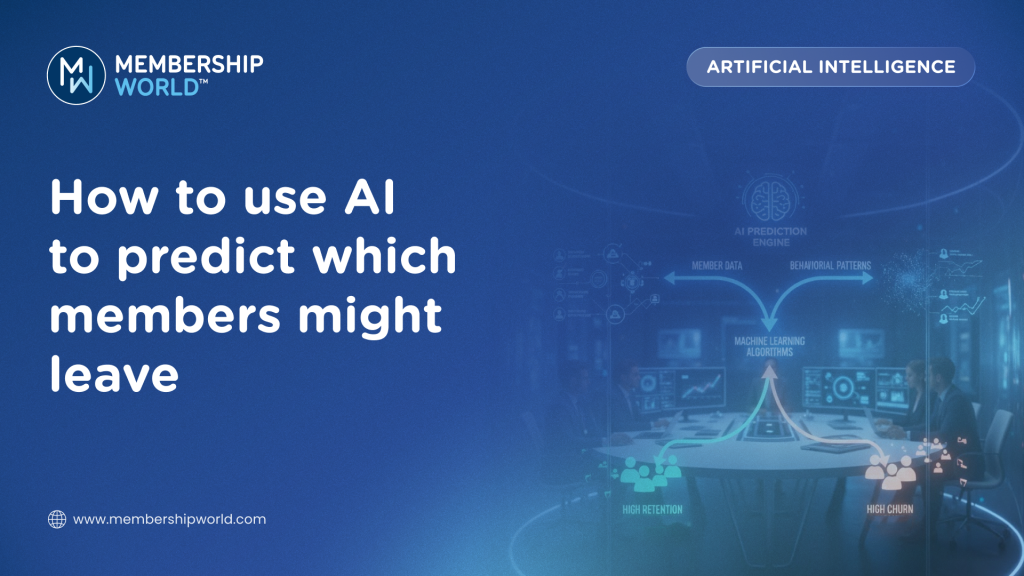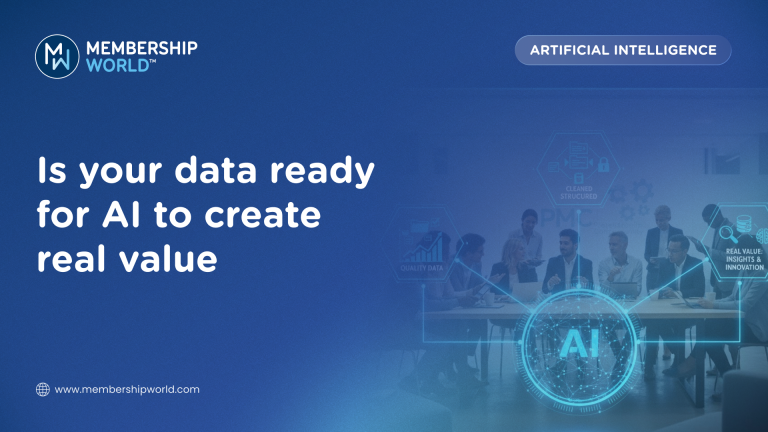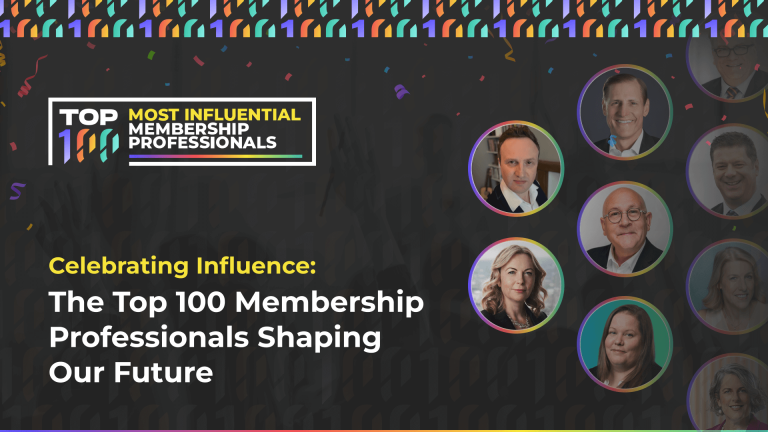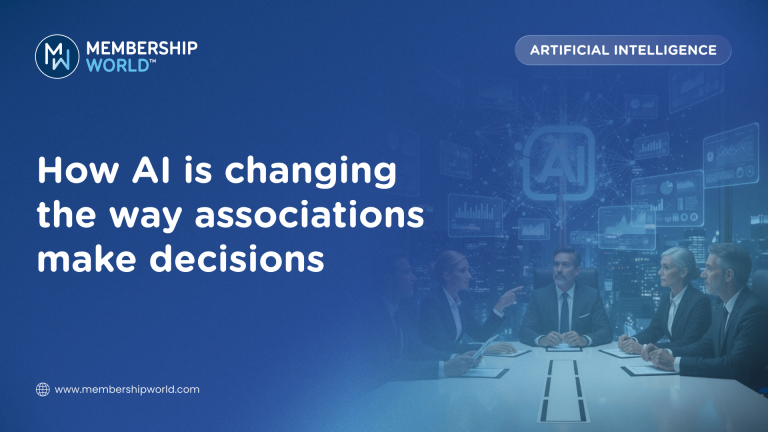
Every association knows the pressure of membership retention.
New members take effort and cost to acquire, but keeping them? That’s where long-term stability and growth come from.
Yet many organisations still rely on gut feeling or late-stage signals — like an expired invoice or a member who hasn’t logged in for months — to identify who’s about to leave.
AI changes that.
Instead of discovering disengagement when it’s too late, associations can now spot early warning signs long before a member decides not to renew.
Predictive analytics isn’t hype — it’s one of the most practical, high-impact uses of AI in the membership sector today.
TLDR
- AI can identify early signs of member churn far earlier than humans can
- It analyses behaviour patterns across data sources to predict who is at risk
- Associations can use these insights to personalise outreach and improve retention
- Success depends on clean data, clear signals, and staff alignment
- AI doesn’t replace relationship-building — it strengthens it by giving teams better focus
Why predicting churn matters so much
Retention is the foundation of financial health, community strength, and mission impact.
But most associations only intervene when a member is already halfway out the door — a reminder email, a phone call, a survey after they’ve gone silent.
The problem is timing.
By the time someone stops attending events or ignores renewal reminders, their decision is usually already made.
AI shifts this from reactive to proactive.
It lets you see what’s coming months before it happens — when you still have time to make a difference.
What AI actually looks at when predicting churn
AI doesn’t “guess.”
It analyses patterns in your existing data — often thousands of micro-signals — to find what departing members typically have in common.
These include:
- Engagement signals
- Drop in event attendance
- Fewer website logins
- Little or no participation in courses
- Reduced newsletter opens
- Behavioural shifts
- Shorter time spent on platforms
- Loss of interest in previously favourite topics
- Decline in forum or community activity
- Transactional data
- Missed payments
- Membership downgrade requests
- Decline in purchases or CPD activity
- Demographic or firmographic trends
- Certain job roles, industries, or locations showing recurring churn patterns
- Support interaction signals
- Increased complaints
- Repeated unresolved questions
- Lower satisfaction scores
No single metric predicts churn.
But taken together, they reveal strong patterns — far stronger than any human could detect manually.
What makes AI so good at this
A member might attend fewer events.
Another might stop opening emails.
Another might simply be too busy for a few weeks.
To the human eye, these seem random.
But AI sees the combinations that matter.
For example, AI might learn that:
- A member who stops opening emails
- AND hasn’t joined an event in three months
- AND hasn’t updated their profile in a year
→ has a 65% chance of not renewing.
These patterns emerge from historical data — AI learns what past churners did and compares it to current behaviour.
The biggest benefit: personalised retention
Once AI identifies members who are “at risk,” associations can intervene early with highly personalised support.
This might include:
- Tailored communication
- “We noticed you haven’t used your CPD allowance recently.”
- “Here are upcoming events based on your interests.”
- Human touchpoints
- A call from the membership team
- An invitation to a small group session
- A check-in from a chapter leader
- Value reminders
- Curated content relevant to their goals
- A badge or certificate they haven’t claimed
- A member story related to their role or sector
- Removing barriers
- Payment plan options
- Help with logging in
- Updates to outdated preferences
The goal is not to chase people — it’s to understand what they value and show you can support it.
A real-world example
One association piloted a churn-prediction model using engagement data from the previous two years.
Within 90 days, they discovered:
- 38% of their upcoming non-renewals had shown clear early signals
- Their team wasn’t aware of most of these members
- Simple check-ins led to a 17% improvement in retention within the pilot group
The lesson?
AI didn’t replace their retention efforts — it made them more targeted, humane, and successful.
How to get started with churn prediction
You don’t need complicated tools to begin.
Most associations can get started with simple models or built-in CRM functionality.
Step 1: Audit your data
You need:
- Engagement logs
- Event attendance
- Email activity
- Support tickets
- Member profile data
Even imperfect data works — patterns will still emerge.
Step 2: Identify your churn signals
Look for behaviours that consistently appear before non-renewal.
Step 3: Choose a simple prediction tool
This could be:
- Your CRM’s built-in scoring
- A third-party analytics tool
- A lightweight AI platform
- Even a spreadsheet model (for early testing)
Step 4: Create retention playbooks
What happens when someone is flagged “at risk”?
Document the steps your team takes.
Step 5: Train your team
Everyone — not just data or membership staff — should understand what churn prediction means and how to act on it.
The human side of predictive retention
AI can tell you who might leave.
It cannot tell you how to care for them.
Retention always comes back to:
- Relevance
- Value
- Connection
AI is a spotlight that shows where to focus your human energy.
It amplifies empathy — it doesn’t replace it.
Final thoughts
Every association is looking for ways to improve retention, create richer member journeys, and build long-lasting relationships.
AI offers a powerful advantage: clarity.
It turns gut feeling into insight.
It turns data into foresight.
It turns scattered signals into early action.
Most importantly, it helps you show up for your members at the moment they need it most.💬 How is your association identifying members at risk of leaving? What signals have you noticed?



